| Revision as of 14:09, 6 September 2006 view sourceCanderson7 (talk | contribs)11,184 editsm fix blanking← Previous edit | Latest revision as of 03:26, 22 November 2024 view source Michael Aurel (talk | contribs)Extended confirmed users12,443 edits Undid revision 1258877011 by Stanley Joseph "Stan" (talk) Rv good-faith edit, per WP:IBP: "The purpose of an infobox is to summarize, but not supplant, the key facts that appear in an article"Tag: Undo | ||
| Line 1: | Line 1: | ||
| {{Short description|Roman adaptation of the Greek divine hero Heracles}} | |||
| {{otheruses}} | |||
| {{About|Hercules in Roman classical mythology|the Greek divine hero from which Hercules was adapted|Heracles|other uses|Hercules (disambiguation)}} | |||
| {{merge|Heracles}} | |||
| {{pp-semi-indef|small=yes}} | |||
| '''Hercules''' is the ] name used in ] for a hero corresponding to the ] hero ''']''' (or '''Herakles'''), the Roman name being a ] of the Greek name. He was son of ], the Roman counterpart to the Greek ] ] and the mortal ]. He was made to perform twelve great tasks, called ''']''' and became a god; the Romans adopted the Greek version of his life and works essentially unchanged, but added anecdotal detail of their own, some of it linking the hero with the geography of the Western Mediterranean. Details of the ] were adapted to Rome as well. | |||
| {{Infobox deity | |||
| | type = Roman | |||
| | name = Hercules | |||
| | image = Hercules combatant Achelous (8655488835).jpg | |||
| | alt = | |||
| | birth_place = | |||
| | death_place = | |||
| | caption = Hercules battles ], metamorphed into a serpent, 1824, by François Joseph Bosio. ] LL 325.<ref>] {{Webarchive|url=https://web.archive.org/web/20200611155621/http://cartelfr.louvre.fr/cartelfr/visite?srv=car_not_frame&idNotice=556 |date=2020-06-11 }}.</ref> | |||
| | god_of = God of strength and heroes | |||
| | abode = Rome | |||
| | symbol = Club, Nemean Lion, bow and arrows | |||
| | consort = | |||
| | parents = ] and ] | |||
| | siblings = | |||
| | children = | |||
| | mount = | |||
| | Greek_equivalent = ] | |||
| | Etruscan_equivalent = ] | |||
| | norse_equivalent = ] | |||
| }} | |||
| '''Hercules''' ({{IPAc-en|ˈ|h|ɜːr|k|j|ʊ|ˌ|l|iː|z}}, {{IPAc-en|US|-|k|j|ə|-|}})<ref>{{cite Collins Dictionary|Hercules}}</ref> is the Roman equivalent of the Greek ] ] ], son of ] and the mortal ]. In ], Hercules is famous for his strength and for his numerous far-ranging adventures. | |||
| ==Character== | |||
| The Romans adapted the Greek hero's ] and myths for their literature and art under the name ''Hercules''. In later ] and literature and in ], ''Hercules'' is more commonly used than ''Heracles'' as the name of the hero. Hercules is a multifaceted figure with contradictory characteristics, which enabled later artists and writers to pick and choose how to represent him.<ref>"Hercules," in ''The Classical Tradition'' (Harvard University Press, 2010), p. 426.</ref> This article provides an introduction to representations of Hercules in the ]. | |||
| Hercules can be identified by his attributes, the ] and the ]: in ] he is shown tanned black, a virile aspect.<ref>The Classical and Hellenistic conventions of frescoes and mosaics is to show women as pale-skinned and men as tanned dark from their outdoor arena of action and exercising in the ].(See also and ).</ref> He is a paragon of action and masculinity, and thus embodies characteristics such as great strength, great courage, and great appetites, including erotic adventures with both women and ]. These qualities did not prevent him from being regarded as a playful figure who used games to relax from his labors and played a great deal with children.<ref>Aelian, ''Varia Historia,'' 12.15</ref> While he was a champion and a great warrior, he was not above cheating and using any unfair trick to his advantage. However, he was renowned as having "made the world safe for mankind" by destroying many dangerous monsters, and he was also held up as an example for never having attacked first, but for having conquered all merely by defending himself when attacked, and protecting the helpless and distraught. His self-sacrifice obtained him the ascent to the Olympian realms and he was welcomed by the gods. | |||
| == |
==Mythology== | ||
| ===Birth and early life=== | |||
| The cult of Hercules may have been the first foreign one to be adopted in Rome. According to legend, Hercules is said to have founded his most important shrine in Rome, the ''Great Altar of Hercules'' (''Ara Maxima Herculis''), later housed within the ], the cattle market of Rome, within Rome's original ] settlement<ref>The various founders of this altar, including Hercules himself, are discussed at the .</ref>. This altar has been dated to the 6th or 5th century BC. It stood near the ]. Hercules became popular with merchants, who customarily paid him a ] of their profits. | |||
| In Roman mythology, although Hercules was seen as the champion of the weak and a great protector, his personal problems started at birth. ] sent two witches to prevent the birth, but they were tricked by one of ]'s servants and sent to another room. Juno then sent ] to kill him in his cradle, but Hercules strangled them both. In one version of the myth, Alcmene abandoned her baby in the woods in order to protect him from Juno's wrath, but he was found by the goddess ] who brought him to Juno, claiming he was an orphan child left in the woods who needed nourishment. Juno suckled Hercules at her own breast until the infant bit her nipple, at which point she pushed him away, spilling her milk across the night sky and so forming the ]. She then gave the infant back to Minerva and told her to take care of the baby herself. In feeding the child from her own breast, the goddess inadvertently imbued him with further strength and power. | |||
| ===Death=== | |||
| ] identified himself with Hercules, and even invented a son of Hercules, called ], from whom Antony claimed descent. In response, his enemy ] identified with ]. | |||
| {{Main article||Heracles#Death}} | |||
| ==Roman era== | |||
| Some early emperors took up the attributes of Hercules (eg Trajan), and later ]s, in particular ] and ], went further and often identified or compared themselves with him and supported his cult; Maximian styled himself "Herculius". | |||
| {{Main article|Hercules in ancient Rome|Heracles}} | |||
| ] sent to kill him in his ] (Roman marble, 2nd century CE, in the ] of ], Italy).]] | |||
| The cult of Hercules spread through the Roman world. In Roman Egypt, what is believed to be the remains of a are found in the ]. | |||
| The ] name ''Hercules'' was borrowed through ], where it is represented variously as ], Hercle, and other forms. Hercules was a favorite subject for ], and appears often on ]s. The Etruscan form ''Herceler''<!--is this right?--> derives from the Greek ''Heracles'' via ]. A mild oath invoking Hercules (''Hercule!'' or ''Mehercle!'') was a common ] in ].<ref>W. M. Lindsay, "Mehercle and Herc(v)lvs. " ''The Classical Quarterly'' '''12'''.2 (April 1918:58).</ref> | |||
| ==]s of Hercules== | |||
| Hercules had a number of ] that were distinctly Roman. One of these is Hercules' defeat of ], who was terrorizing the countryside of Rome. The hero was associated with the ] through his son ]. ] considered him a personal patron god, as did the emperor ]. Hercules received various forms of ], including as a ], in part because of myths about his precocious infancy, and in part because he fathered countless children. Roman brides wore a special belt tied with the "]", which was supposed to be hard to untie.<ref>] 55 (edition of Lindsay); ], ''The Roman Festivals of the Period of the Republic'' (London, 1908), p. 142; Karen K. Hersch, ''The Roman Wedding: Ritual and Meaning in Antiquity'' (Cambridge University Press, 2010), pp. 101, 110, 211.</ref> The comic playwright ] presents the myth of Hercules' conception as a sex comedy in his play '']''; ] wrote the tragedy ''Hercules Furens'' about his bout with madness. During the ], Hercules was worshipped locally from ] through ]. | |||
| ],'' by ], 1525 - 1534. Piazza della Signoria, ]]] | |||
| ===Germanic association=== | |||
| The Romans adopted the ] of Heracles' life and works essentially unchanged, but added anecdotal detail of their own, some of it linking Hercules with the geography of the Western Mediterranean. | |||
| ] depicting ] and ] from ]-], 1st century CE.]] | |||
| ] records a special affinity of the ] for Hercules. In chapter 3 of his '']'', Tacitus states: | |||
| In ], ] was Hercules' mistress. She was married to ], a wealthy merchant. When he died, she gave his money to charity. In another version, she was the wife of ]. | |||
| {{blockquote|... they say that Hercules, too, once visited them; and when going into battle, they sang of him first of all heroes. They have also those songs of theirs, by the recital of this ''barditus''<ref>or, ''baritus'', there being scribal variants. In the 17th century, the word entered the German language as ''barditus'' and was associated with the Celtic ]s.</ref> as they call it, they rouse their courage, while from the note they augur the result of the approaching conflict. For, as their line shouts, they inspire or feel alarm.}} | |||
| == Hercules in popular ] == | |||
| Some have taken this as Tacitus equating the Germanic '']'' with Hercules by way of ''interpretatio romana''.<ref>Simek, Rudolf (2007:140–142) translated by Angela Hall. ''Dictionary of Northern Mythology''. D.S. Brewer. {{ISBN|0-85991-513-1}}</ref> | |||
| Since the Renaissance, Hercules has rarely been distinguished from Heracles, the Roman figure overshadowing the Greek. Later interpretations of Hercules' legend cast him as a wise leader and a good friend (many of the movie and TV adaptations cast him in this light, especially the 1995-1999 syndicated TV series). The legend of Hercules endures, though often co-opted to suit the political fashion of the day. Hercules has also had an undeniable influence on modern pop culture characters such as ], the main protagonist of the ''Masters of the Universe'' series, who is also widely admired for his massive strength. | |||
| In the Roman era ] amulets appear from the 2nd to 3rd century, distributed over the empire (including ], cf. Cool 1986), mostly made of gold, shaped like wooden clubs. A specimen found in ] bears the inscription <small>"DEO HER</small>", confirming the association with Hercules. | |||
| The legend of Hercules has been described in many movie and television adaptations. | |||
| In the 5th to 7th centuries, during the ], the amulet is theorized to have rapidly spread from the ] area across Europe. These Germanic "]" were made from deer antler, bone or wood, more rarely also from bronze or precious metals. The amulet type is replaced by the ] ] pendants in the course of the ] from the 8th to 9th century. | |||
| ===TV and movies=== | |||
| {{clear}} | |||
| ==Medieval mythography== | |||
| A series of 19 Italian Hercules movies were made in the late 50's/ early 60's. The actors who played Hercules in these films were ], Gordon Scott, Kirk Morris, Mickey Hargitay, Mark Forest, Alan Steel, Dan Vadis, Brad Harris, Reg Park, Rock Stevens and Michael Lane. The films are listed below by their American release titles, and the titles in parentheses are the original Italian titles (if they were different). | |||
| ] in the 15th-century '']'']] | |||
| After the Roman Empire became ], mythological narratives were often reinterpreted as ], influenced by the philosophy of ]. In the 4th century, ] had described Hercules' return from the underworld as representing his ability to overcome earthly desires and vices, or the earth itself as a consumer of bodies.<ref>], note to '']'' {{Webarchive|url=https://web.archive.org/web/20200801183425/http://www.perseus.tufts.edu/hopper/text?doc=Serv.+A.+6.395&fromdoc=Perseus%3Atext%3A1999.02.0053 |date=2020-08-01 }}; Jane Chance, ''Medieval Mythography: From Roman North Africa to the School of Chartres, A.D. 433–1177'' (University Press of Florida, 1994), p. 91.</ref> In medieval mythography, Hercules was one of the heroes seen as a strong role model who demonstrated both valor and wisdom, while the monsters he battles were regarded as moral obstacles.<ref>Chance, ''Medieval Mythography'', pp. 168, 218, 413.</ref> One ] noted that when ], he showed that strength was necessary to gain entrance to Heaven.<ref>Chance, ''Medieval Mythography'', p. 219.</ref> | |||
| *''Hercules'' (Le Fatiche di Ercole/ The Labors of Hercules, 1957) starring Steve Reeves | |||
| *''Hercules Unchained'' (Ercole e la regina di Lidia/ Hercules and the Queen of Lydia, 1959) starring Steve Reeves | |||
| *''Goliath and the Dragon'' (La Vendetta di Ercole/ The Revenge of Hercules, 1960) (this Hercules film had its title changed to "Goliath" when it was distributed in the USA for some reason) | |||
| *''Hercules Vs The Hydra'' (Gli Amori di Ercole/ The Loves of Hercules, 1960) co-starring Jayne Mansfield | |||
| *''Hercules and the Captive Women'' (Ercole alla conquista di Atlantide/ Hercules at the Conquest of Atlantis, aka Hercules and the Haunted Women) 1961 | |||
| *''Hercules in the Haunted World'' (Ercole al centro della terra/ Hercules at the Center of the Earth) 1961 (directed by Mario Bava) | |||
| *''Hercules in the Vale of Woe'' (Maciste contro Ercole nella valle dei guai/ Maciste Vs. Hercules in the Vale of Woe) 1961 (this was made as a semi-comedy/ satire on peplums) | |||
| *''Ulysses Vs. The Son of Hercules'' (Ulisse contro Ercole/ Ulysses Vs. Hercules) 1962 | |||
| *''The Fury of Hercules'' (La Furia di Ercole/ The Fury of Hercules, aka The Fury of Samson) 1962 | |||
| *''Hercules, Samson and Ulysses'' (Ercole sfida Sansone/ Hercules Challenges Samson) 1963 | |||
| *''Hercules Vs. the Moloch'' (Ercole contro Molock/ Hercules Vs. Moloch, aka The Conquest of Mycene) 1963 | |||
| *''Son of Hercules in the Land of Darkness'' (Ercole l'invincibile/ Hercules, the Invincible) 1964 (this was originally a Hercules film that was retitled to "Son of Hercules" so that it could be included in the "Sons of Hercules" TV syndication package) | |||
| *''Hercules Vs. The Giant Warrior'' (il Trionfo di Ercole/ The Triumph of Hercules, aka Hercules and the Ten Avengers) 1964 | |||
| *''Hercules Against Rome'' (Ercole contro Roma, 1964) | |||
| *''Hercules Against the Sons of the Sun'' (Ercole contro i figli del sole, 1964) | |||
| *''Hercules and the Tyrants of Babylon'' (Ercole contro i tiranni di Babilonia, 1964) | |||
| *''Samson and the Mighty Challenge'' (Ercole, Sansone, Maciste e Ursus: gli invincibili, aka Combate dei Gigantes) 1964 (this was more of a comedy/ satire on peplums & featured Hercules prominently in the plot) | |||
| *''Hercules and the Princess of Troy'' (no Italian title, aka "Hercules vs. the Sea Monster", 1965) (this 48-minute Italian/U.S. co-production was made as a pilot for a Charles Band-produced TV series that never materialized) | |||
| *''Hercules, the Avenger'' (Sfida dei giganti/Challenge of the Giants, 1965) this was a cheaply made-for-TV quickie that consisted mostly of re-edited stock footage from 2 earlier Hercules films, “Hercules and the Captive Women” and “Hercules in the Haunted World”. | |||
| Medieval mythography was written almost entirely in Latin, and original Greek texts were little used as sources for Hercules' myths. | |||
| A number of English-dubbed Italian films that featured the Hercules name in their title were never intended to be Hercules movies by their Italian creators. | |||
| * "Hercules, Prisoner of Evil" was actually a retitled Ursus film. | |||
| * "Hercules and the Black Pirate" and "Hercules and the Treasure of the Incas" were both retitled Samson movies (the second film not even being a sword-and-sandal film). | |||
| * "Hercules and the Masked Rider" was actually a retitled Goliath movie. | |||
| * "Hercules Against the Moon Men", "Hercules Against the Barbarians", "Hercules Against the Mongols" and "Hercules of the Desert" were all originally Maciste films. | |||
| None of these films in their original Italian versions were connected to the Hercules character in any way. Likewise, most of the "Sons of Hercules" movies shown on American TV in the 1960's had nothing to do with Hercules in their original Italian incarnations. | |||
| {{clear}} | |||
| * '']'', a weekly syndicated TV series which repackaged Italian Muscleman films which the distributors didn't feel merited full-blown theatrical releases in the USA | |||
| * '']'', a 1963 British special effects film by Ray Harryhausen, includes Hercules as a character played by ] | |||
| * '']'', a 1963 B&W comedy involving time travel | |||
| * '']'', a 1963 animated cartoon series, | |||
| * '']'', a 1969 film starring ] | |||
| * ''Hercules 1 and 2'', two 1983 Italian films made back-to-back starring ] | |||
| * '']'', 1995-1999 television series with ] | |||
| * '']'', a Disney Animated movie which deviated from the myth. | |||
| * '']'', 1998-99 | |||
| * ''] | |||
| * '']'', an NBC TV movie starring ] | |||
| * '' ], which features one of the main characters as legal ancestor of Hercules, Perseus, a creation/son of Zeus. | |||
| ==Renaissance mythography== | |||
| ===Video Games=== | |||
| ] depicted as Hercules vanquishing the ] (i.e. the ]), by ], {{circa|1600}}]] | |||
| *Hercules: The Legendary Journeys was given a ] where he fought against his evil half-brother ], loosely based on the series. | |||
| * - A freeware game of Hercules and one of his great adventures created by 17 year old Michael Becker. | |||
| *Disney's Hercules has a ] ]. | |||
| *] is a tongue-in-cheek adventure-] on the ] where you must complete many tasks, many of which are not actually credited to Hercules anywhere else (such as slaying ]). | |||
| *Heracles is a ] game where he must free ] from the clutches of the evil god ]. | |||
| *Hercules appeared in ] and ] | |||
| The ] and the invention of the ] brought a renewed interest in and publication of Greek literature. Renaissance mythography drew more extensively on the Greek tradition of Heracles, typically under the Romanized name Hercules, or the alternate name ]. In a chapter of his book ''Mythologiae'' (1567), the influential mythographer ] collected and summarized an extensive range of myths concerning the birth, adventures, and death of the hero under his Roman name Hercules. Conti begins his lengthy chapter on Hercules with an overview description that continues the moralizing impulse of the Middle Ages: | |||
| ===Children's Tales=== | |||
| <blockquote> | |||
| Hercules, who subdued and destroyed monsters, bandits, and criminals, was justly famous and renowned for his great courage. His great and glorious reputation was worldwide, and so firmly entrenched that he'll always be remembered. In fact the ancients honored him with his own temples, altars, ceremonies, and priests. But it was his wisdom and great soul that earned those honors; noble blood, physical strength, and political power just aren't good enough.<ref>], ''Mythologiae'' Book 7, Chapter 1, as translated by John Mulryan and Steven Brown (Arizona Center for Medieval and Renaissance Studies, 2006), vol. 2, p. 566.</ref> | |||
| Hercules' tale was later toned down into a children's movie. He is still presented as an illegitimate son of ], where he performed the labors when he causes an accident that claims the life of his mother. His half-brother Iphicles was never revealed, he is helped by Athena in one of his labors which was to defeat the stymphalian birds and he never confronts Hera. It's a happy ending since he marries Megara in the end and they are assumed to live happily ever after. The reason was because of the gory nature of the original story. | |||
| </blockquote> | |||
| In 1600, the citizens of ] bestowed on ] (the future King ]) the title of the ''Hercule Gaulois'' ("Gallic Hercules"), justifying the extravagant flattery with a genealogy that traced the origin of the House of Navarre to a nephew of Hercules' son Hispalus.<ref>The official account, ''Labyrinthe royal...'' quoted in ], ''The Survival of the Pagan Gods'', (B.F. Sessions, tr., 1995) p. 26</ref> | |||
| ===Comic books=== | |||
| == Worship == | |||
| Hercules has also appeared in several comic book adaptations: | |||
| === Road of Hercules === | |||
| *''Hercules'' (a 1958 Dell comic adapting the film) | |||
| *''Hercules Unchained'' (a 1959 Dell comic adapting the film) | |||
| The Road of Hercules is a route across Southern Gaul that is associated with the path Hercules took during his 10th labor of retrieving the Cattle of Geryon from the Red Isles.<ref name=":0">{{Cite journal|last=Dewitt|first=Norman|date=February 22, 2020|title=Rome and the 'Road of Hercules'|journal=Transactions and Proceedings of the American Philological Association|volume=72|pages=59–69|doi=10.2307/283041|jstor=283041}}</ref> Hannibal took the same path on his march towards Italy and encouraged the belief that he was the second Hercules.<ref name=":0" /> Primary sources often make comparisons between Hercules and Hannibal.<ref name=":0" /> Hannibal further tried to invoke parallels between himself and Hercules by starting his march on Italy by visiting the shrine of Hercules at Gades. While crossing the alps, he performed labors in a heroic manner. A famous example was noted by Livy, when Hannibal fractured the side of a cliff that was blocking his march.<ref name=":0" /> | |||
| *] | |||
| *] | |||
| === Worship from women === | |||
| In ancient Roman society women were usually limited to two types of cults: those that addressed feminine matters such as childbirth, and cults that required virginal chastity.<ref name=":1">{{Cite journal|last=Schultz|first=Cecelia|date=February 22, 2020|title=Modern Prejudice and Ancient Praxis: Female Worship of Hercules at Rome|journal=Zeitschrift für Papyrologie und Epigraphik|volume=133|pages=291–97}}</ref> However, there is evidence suggesting there were female worshippers of Apollo, Mars, Jupiter, and Hercules.<ref name=":1" /> Some scholars believe that women were completely prohibited from any of Hercules's cults. Others believe it was only the "Ara Maxima" at which they were not allowed to worship.<ref name=":1" /> ] in his first book of ''Saturnalia'' paraphrases from Varro: "For when Hercules was bringing the cattle of Geryon through Italy, a woman replied to the thirsty hero that she could not give him water because it was the day of the Goddess Women and it was unlawful for a man to taste what had been prepared for her. Hercules, therefore, when he was about to offer a sacrifice forbid the presence of women and ordered Potitius and Pinarius who were in charge of his rites, not to allow any women from taking part".<ref name=":1" /> Macrobius states that women were restricted in their participation in Hercules cults, but to what extent remains ambiguous. He mentions that women were not allowed to participate in Sacrum which is general term used to describe anything that was believed to have belonged to the gods. This could include anything from a precious item to a temple. Due to the general nature of a Sacrum, we can not judge the extent of the prohibition from Macrobius alone.<ref name=":1" /> There are also ancient writings on this topic from Aulus Gellius when speaking on how Romans swore oaths. He mentioned that Roman women do not swear on Hercules, nor do Roman men swear on Castor.<ref name=":1" /> He went on to say that women refrain from sacrificing to Hercules.<ref name=":1" /> Propertius in his poem 4.9 also mentions similar information as Macrobius. This is evidence that he was also using Varro as a source.<ref name=":1" /> | |||
| === Worship in myth === | |||
| There is evidence of Hercules worship in myth in the Latin epic poem, the '']''. In the 8th book of the poem ] finally reaches the future site of Rome, where he meets ] and the Arcadians making sacrifices to Hercules on the banks of the Tiber river.<ref name=":2">{{Cite journal|last=Loar|first=Matthew|date=February 23, 2020|title=Hercules, Mummius, and the Roman Triumph in Aeneid 8|journal=Classical Philology |volume=112|pages=45–62|doi=10.1086/689726|s2cid=164402027|url=https://digitalcommons.unl.edu/cgi/viewcontent.cgi?article=1139&context=classicsfacpub}}</ref> They share a feast, and Evander tells the story of how Hercules defeated the monster Cascus, and describes him as a triumphant hero.<ref name=":2" /> Translated from the Latin text of Vergil, Evander stated: "Time brought to us in our time of need the aid and arrival of a god. For there came that mightiest avenger, the victor Hercules, proud with the slaughter and the spoils of threefold Geryon, and he drove the mighty bulls here, and the cattle filled both valley and riverside.<ref name=":2" /> | |||
| Hercules was also mentioned in the Fables of ]. For example, in his fable about ] he tells the story of how Philoctetes built a funeral pyre for Hercules so his body could be consumed and raised to immortality.<ref>{{Cite web|url=https://www.theoi.com/Text/HyginusFabulae3.html|title=Hyginus, Fabulae, 100–49|last=Grant|first=Mary|website=Theoi Texts Library|access-date=March 7, 2020}}</ref> | |||
| === Hercules and the Roman triumph=== | |||
| According to Livy (9.44.16) Romans were commemorating military victories by building statues to Hercules as early as 305 BCE. Also, philosopher ] dates Hercules worship back to the time of Evander, by accrediting him with erecting a statue in the Forum Boarium of Hercules.<ref name=":22">{{Cite journal|last=Loar|first=Matthew|date=February 23, 2020|title=Hercules, Mummius, and the Roman Triumph in Aeneid 8|journal=Classical Philology|volume=112|pages=45–62|doi=10.1086/689726|s2cid=164402027|url=https://digitalcommons.unl.edu/cgi/viewcontent.cgi?article=1139&context=classicsfacpub}}</ref> Scholars agree that there would have been 5–7 temples in Augustan Rome.<ref name=":22" /> There are believed to be related Republican ''triumphatores'', however, not necessarily triumphal dedications. There are two temples located in the Campus Martius. One, being the Temple of Hercules Musarum, dedicated between 187 and 179 BCE by M. Fulvius Nobilior.<ref name=":22" /> And the other being the Temple of Hercules Custos, likely renovated by Sulla in the 80s BCE.<ref name=":22" /> | |||
| ===In art=== | |||
| In Roman works of art and in Renaissance and post-Renaissance art, Hercules can be identified by his attributes, the ] and the gnarled ] (his favorite weapon); in ] he is shown tanned bronze, a virile aspect.<ref>''Hercules'' almost suggests "Hero". The Classical and Hellenistic convention in frescoes and mosaics, adopted by the Romans, is to show women as pale-skinned and men as tanned dark from their outdoor arena of action and exercising in the ].(See also {{Webarchive|url=https://web.archive.org/web/20060506182021/http://academic.reed.edu/humanities/110Tech/RomanAfrica2/pompei%26herc1.jpg |date=2006-05-06 }}, jpg file. {{Webarchive|url=https://web.archive.org/web/20060823062542/http://academic.reed.edu/humanities/110Tech/RomanAfrica2/#Subject |date=2006-08-23 }}, subject).</ref> | |||
| In the twentieth century, the '']'' has inspired artists such as ], ] and ] to reinterpret Hercules for new audiences.<ref name=":3">{{Cite web|last=Hinds|first=Aimee|title=Hercules in White: Classical Reception, Art and Myth|url=https://www.thejugaadproject.pub/home/hercules-in-white-classical-reception-art-and-myth|access-date=2020-10-22|website=The Jugaad Project|date=23 June 2020 |language=en-US}}</ref> The choice of deliberately white materials by Koons and Darbyshire has been interpreted as perpetuation of colourism in how the classical world is viewed.<ref name=":3" /> Mapplethorpe's work with black model Derrick Cross can be seen as a reaction to Neo-classical colourism, resisting the portrayal of Hercules as white.<ref name=":3" /> | |||
| ===Roman era=== | |||
| <gallery mode="packed" heights="220"> | |||
| File:Heracles Pio-Clementino Inv252.jpg|'']'' (Hellenistic, 2nd century BCE) | |||
| File:Affresco romano eracle ebbro e onfale.JPG|Hercules drunk and ]. Fresco from House of the Prince of Montenegro, ], 25–35 CE | |||
| File:Hercules Nessus MAN Napoli Inv9001.jpg|Hercules carrying his son ] looks at the centaur ], who is about to carry ] across the river on his back. Fresco from Pompeii, 30–45 CE | |||
| File:Herculaneum Collegio degli Augustali Ercole sull'Olimpo.jpg|Hercules in Olympus with ] and ], fresco from ], 1st century CE | |||
| File:Hercules and Iolaus mosaic - Anzio Nymphaeum.jpg|Hercules and ] (1st century CE mosaic from the Anzio Nymphaeum, Rome) | |||
| File:Hercules Hatra Iraq Parthian period 1st 2nd century CE.jpg|Hercules (], Iraq, ], 1st–2nd century CE) | |||
| File:Muze 001.jpg|Hercules bronze statuette, 2nd century CE (museum of ], Turkey) | |||
| File:Missorium Herakles lion Cdm Paris 56-345 n3.jpg|Hercules and the ] (detail), ] ], 6th century (], Paris) | |||
| File:Affresco romano - eracle ed onfale - area vesuviana.JPG|Heracles and ], Roman fresco, ] (45–79 CE), ], Italy | |||
| File:Tesoro di hildesheim, argento, I sec ac-I dc ca., piatto da parata con ercole bambino e i serpenti 01.JPG|A Roman gilded silver bowl depicting the boy Hercules strangling two serpents, from the ], 1st century CE, ] | |||
| File:Head from statue of Herakles (Hercules) Roman 117-188 CE from villa of the emperor Hadrian at Tivoli, Italy BM 2.jpg|Head from statue of Herakles (Hercules) Roman 117–188 CE from villa of the emperor Hadrian at Tivoli, Italy at the British Museum | |||
| File:Herakles with the Apples of the Hesperides Roman 1st century CE from a temple at Byblos Lebanon BM.jpg|Hercules (Herakles) with the Apples of the Hesperides Roman 1st century CE from a temple at Byblos, Lebanon at the British Museum | |||
| File:Hercules from Cappadocia or Caesarea 1st century BCE - 1st century CE Walters Art Museum.jpg|Hercules from Cappadocia or Caesarea 1st century BCE – 1st century CE, Walters Art Museum | |||
| File:Hercules slaying the Hydra Roman copy of 4th century BCE original by Lysippos Capitoline Museum.jpg|Hercules slaying the Hydra Roman copy of 4th century BCE original by Lysippos, Capitoline Museum | |||
| File:Hercules Roman 1st century BCE - 1st century CE Walters Art Museum.jpg|Hercules Roman 1st century BCE – 1st century CE, Walters Art Museum | |||
| File:Herakles and Telephos Louvre MR219.jpg|Herakles and Telephos Louvre MR219 | |||
| File:Ercole seduto (epitrapezios), 50 ac-50 dc ca., con braccia, clava e gambe sotto il ginocchio di restauro 02.JPG|Hercules, 50 BCE – 50 CE, MAN Florence | |||
| </gallery> | |||
| ===Modern era=== | |||
| <gallery mode="packed" heights="220"> | |||
| File:Hendrik Goltzius, The Great Hercules, 1589, NGA 70311.jpg|''The Giant Hercules'' (1589) by ] | |||
| File:Lucas Faydherbe, Buste van Hercules - Buste d'Hercule, KBS-FRB.jpg|], ] – collection ] | |||
| File:Peter Paul Rubens cat01.jpg|''The Drunken Hercules'' (1612–1614) by ] | |||
| File:HerculeDejanire.jpg|''Hercules and ]'' (18th century copy of a lost original), from ] | |||
| File:Brooklyn Museum - Les Écuries d'Augias - Honoré Daumier.jpg|Hercules in the ] (1842, ]) | |||
| File:Hercules Comic Cover.JPG|<!--deliberate link to disambig follows-->] cover ({{Circa|1958}}) | |||
| File:Bartholomäus Spranger - Hercules, Deianira and the Centaur Nessus - Google Art Project.jpg|''Hercules, ] and the Centaur Nessus'', by ], 1580–1582 | |||
| File:Henry IV en Herculeus terrassant l Hydre de Lerne cad La ligue Catholique Atelier Toussaint Dubreuil circa 1600.jpg|], as Hercules vanquishing the ] (i.e. the ]), by ], {{Circa|1600}}. ] | |||
| File:Herakles pyre Coustou Louvre MR1809.jpg|Hercules on the Pyre by Guillaume Coustou The Elder, 1704, Louvre MR1809 | |||
| </gallery> | |||
| ===In numismatics=== | |||
| Hercules was among the earliest figures on ancient Roman coinage, and has been the main motif of many collector coins and medals since. One example is the Austrian ] issued on September 11, 2002. The obverse side of the coin shows the Grand Staircase in the town palace of ] in ], currently the Austrian Ministry of Finance. Gods and ] hold its flights, while Hercules stands at the turn of the stairs. | |||
| <gallery> | |||
| File:Æ Triens 2710028.jpg|], with Hercules fighting a ] on reverse (Roman, 215–15 BCE) | |||
| File:Denarius Publius Cornelius Lentulus Marcellinus 1 Obverse.jpg|Club over his shoulder on a Roman ] ({{Circa|100 BCE}}) | |||
| File:MAXIMINUS II-RIC VI 77-251201.jpg|] and Hercules with club and lionskin (Roman, 313 CE) | |||
| File:5 French francs Hercule de Dupré 1996 F346-2 obverse.jpg|Commemorative ] piece (1996), Hercules in center | |||
| File:Caracalla Denarius Hercules RIC192.jpg|Hercules, as seen on a Denarius of the Roman Emperor Caracalla. Dated 212 CE | |||
| </gallery> | |||
| {{Clear}} | |||
| ===Military=== | |||
| {{for|ships named Hercules|Hercules (ship)}} | |||
| Six successive ships of the British ], from the 18th to the 20th century, bore the name ]. | |||
| In the ], there were no less than nineteen ships called '']'', plus three more named '']'' which is another name of the same hero. | |||
| Hercules' name was also used for five ships of the ], four ships of the ], four of the ] and two of the ], as well as for numerous civilian sailing and steam ships. | |||
| In modern aviation a ] produced by ] carries the title ]. | |||
| ] was the German code-name given to an abortive plan for the invasion of ] during the ]. | |||
| ===Other cultural references=== | |||
| <gallery> | |||
| File:PillarsHerculesPeutingeriana.jpg|], representing the ] (19th-century conjecture of the '']'') | |||
| File:Maczuga Herkulesa (background Castle Pieskowa Skała).jpg|'']'', a tall ] rock formation, with ] in the background | |||
| File:Royal Coat of Arms of Greece.svg|Hercules as ] in the ] of ], in use 1863–1973. The phrase "Ηρακλείς του στέμματος" ("Defenders of the Crown") has pejorative connotations ("chief henchmen") in Greek. | |||
| </gallery> | |||
| ===In films=== | |||
| {{For|a list of films featuring Hercules|Hercules in popular culture#Filmography}} | |||
| A series of nineteen Italian Hercules movies were made in the late 1950s and early 1960s. The actors who played Hercules in these films were ], ], Kirk Morris, ], Mark Forest, Alan Steel, ], ], ], ] (billed as ]) and Michael Lane. A number of English-dubbed Italian films that featured the name of Hercules in their title were not intended to be movies about Hercules. | |||
| ==See also== | ==See also== | ||
| * ] | |||
| * ] | |||
| * ] | |||
| * ] of the 20th and 21st centuries | |||
| * ] | |||
| * '']'' | |||
| * ] | |||
| * ] | |||
| * ] | |||
| * ] | |||
| * ] | |||
| * ] | |||
| ==References== | |||
| ;Notes | |||
| {{Reflist}} | |||
| ;Sources | |||
| * Charlotte Coffin. {{Webarchive|url=https://web.archive.org/web/20210228164206/http://www.shakmyth.org/myth/111/hercules |date=2021-02-28 }} in Peyré, Yves (ed.) ''A Dictionary of Shakespeare's Classical Mythology'' (2009) | |||
| * Bertematti, Richard (2014). (Tridium Press). {{ISBN|0990302717}} | |||
| ==External links== | |||
| *] | |||
| {{Commons category}} | |||
| *] | |||
| * {{Wikisource-inline|list= | |||
| *] (]) | |||
| ** {{Cite Nuttall|title=Hercules|noicon=x|short=1}} | |||
| *] | |||
| ** {{Cite NSRW|wstitle=Hercules|short=1|noicon=x}} | |||
| ** "]," by ] | |||
| ** "]," from '']'' by ] | |||
| * | |||
| * | |||
| * | |||
| * | |||
| * | |||
| * | |||
| }} | |||
| {{Labours of Heracles}} | |||
| ] | |||
| {{Hercules media}} | |||
| {{Authority control}} | |||
| ] | |||
| ] | |||
| ] | |||
| ] | |||
| ] | |||
| ] | |||
| ] | |||
| ] | |||
| ] | ] | ||
| ] | |||
| ] | |||
| ] | |||
Latest revision as of 03:26, 22 November 2024
Roman adaptation of the Greek divine hero Heracles This article is about Hercules in Roman classical mythology. For the Greek divine hero from which Hercules was adapted, see Heracles. For other uses, see Hercules (disambiguation).
| Hercules | |
|---|---|
| God of strength and heroes | |
 Hercules battles Achelous, metamorphed into a serpent, 1824, by François Joseph Bosio. Louvre LL 325. Hercules battles Achelous, metamorphed into a serpent, 1824, by François Joseph Bosio. Louvre LL 325. | |
| Abode | Rome |
| Symbol | Club, Nemean Lion, bow and arrows |
| Parents | Jupiter and Alcmena |
| Equivalents | |
| Etruscan | Hercle |
| Greek | Heracles |
| Norse | Hercules Magusanus |
Hercules (/ˈhɜːrkjʊˌliːz/, US: /-kjə-/) is the Roman equivalent of the Greek divine hero Heracles, son of Jupiter and the mortal Alcmena. In classical mythology, Hercules is famous for his strength and for his numerous far-ranging adventures.
The Romans adapted the Greek hero's iconography and myths for their literature and art under the name Hercules. In later Western art and literature and in popular culture, Hercules is more commonly used than Heracles as the name of the hero. Hercules is a multifaceted figure with contradictory characteristics, which enabled later artists and writers to pick and choose how to represent him. This article provides an introduction to representations of Hercules in the later tradition.
Mythology
Birth and early life
In Roman mythology, although Hercules was seen as the champion of the weak and a great protector, his personal problems started at birth. Juno sent two witches to prevent the birth, but they were tricked by one of Alcmene's servants and sent to another room. Juno then sent serpents to kill him in his cradle, but Hercules strangled them both. In one version of the myth, Alcmene abandoned her baby in the woods in order to protect him from Juno's wrath, but he was found by the goddess Minerva who brought him to Juno, claiming he was an orphan child left in the woods who needed nourishment. Juno suckled Hercules at her own breast until the infant bit her nipple, at which point she pushed him away, spilling her milk across the night sky and so forming the Milky Way. She then gave the infant back to Minerva and told her to take care of the baby herself. In feeding the child from her own breast, the goddess inadvertently imbued him with further strength and power.
Death
Main article: Heracles § DeathRoman era
Main articles: Hercules in ancient Rome and Heracles
The Latin name Hercules was borrowed through Etruscan, where it is represented variously as Heracle, Hercle, and other forms. Hercules was a favorite subject for Etruscan art, and appears often on bronze mirrors. The Etruscan form Herceler derives from the Greek Heracles via syncope. A mild oath invoking Hercules (Hercule! or Mehercle!) was a common interjection in Classical Latin.
Hercules had a number of myths that were distinctly Roman. One of these is Hercules' defeat of Cacus, who was terrorizing the countryside of Rome. The hero was associated with the Aventine Hill through his son Aventinus. Mark Antony considered him a personal patron god, as did the emperor Commodus. Hercules received various forms of religious veneration, including as a deity concerned with children and childbirth, in part because of myths about his precocious infancy, and in part because he fathered countless children. Roman brides wore a special belt tied with the "knot of Hercules", which was supposed to be hard to untie. The comic playwright Plautus presents the myth of Hercules' conception as a sex comedy in his play Amphitryon; Seneca wrote the tragedy Hercules Furens about his bout with madness. During the Roman Imperial era, Hercules was worshipped locally from Hispania through Gaul.
Germanic association

Tacitus records a special affinity of the Germanic peoples for Hercules. In chapter 3 of his Germania, Tacitus states:
... they say that Hercules, too, once visited them; and when going into battle, they sang of him first of all heroes. They have also those songs of theirs, by the recital of this barditus as they call it, they rouse their courage, while from the note they augur the result of the approaching conflict. For, as their line shouts, they inspire or feel alarm.
Some have taken this as Tacitus equating the Germanic Þunraz with Hercules by way of interpretatio romana.
In the Roman era Hercules' Club amulets appear from the 2nd to 3rd century, distributed over the empire (including Roman Britain, cf. Cool 1986), mostly made of gold, shaped like wooden clubs. A specimen found in Köln-Nippes bears the inscription "DEO HER", confirming the association with Hercules.
In the 5th to 7th centuries, during the Migration Period, the amulet is theorized to have rapidly spread from the Elbe Germanic area across Europe. These Germanic "Donar's Clubs" were made from deer antler, bone or wood, more rarely also from bronze or precious metals. The amulet type is replaced by the Viking Age Thor's hammer pendants in the course of the Christianization of Scandinavia from the 8th to 9th century.
Medieval mythography

After the Roman Empire became Christianized, mythological narratives were often reinterpreted as allegory, influenced by the philosophy of late antiquity. In the 4th century, Servius had described Hercules' return from the underworld as representing his ability to overcome earthly desires and vices, or the earth itself as a consumer of bodies. In medieval mythography, Hercules was one of the heroes seen as a strong role model who demonstrated both valor and wisdom, while the monsters he battles were regarded as moral obstacles. One glossator noted that when Hercules became a constellation, he showed that strength was necessary to gain entrance to Heaven.
Medieval mythography was written almost entirely in Latin, and original Greek texts were little used as sources for Hercules' myths.
Renaissance mythography
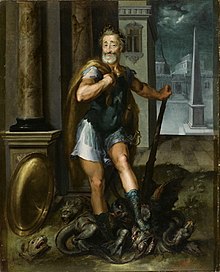
The Renaissance and the invention of the printing press brought a renewed interest in and publication of Greek literature. Renaissance mythography drew more extensively on the Greek tradition of Heracles, typically under the Romanized name Hercules, or the alternate name Alcides. In a chapter of his book Mythologiae (1567), the influential mythographer Natale Conti collected and summarized an extensive range of myths concerning the birth, adventures, and death of the hero under his Roman name Hercules. Conti begins his lengthy chapter on Hercules with an overview description that continues the moralizing impulse of the Middle Ages:
Hercules, who subdued and destroyed monsters, bandits, and criminals, was justly famous and renowned for his great courage. His great and glorious reputation was worldwide, and so firmly entrenched that he'll always be remembered. In fact the ancients honored him with his own temples, altars, ceremonies, and priests. But it was his wisdom and great soul that earned those honors; noble blood, physical strength, and political power just aren't good enough.
In 1600, the citizens of Avignon bestowed on Henry of Navarre (the future King Henry IV of France) the title of the Hercule Gaulois ("Gallic Hercules"), justifying the extravagant flattery with a genealogy that traced the origin of the House of Navarre to a nephew of Hercules' son Hispalus.
Worship
Road of Hercules
The Road of Hercules is a route across Southern Gaul that is associated with the path Hercules took during his 10th labor of retrieving the Cattle of Geryon from the Red Isles. Hannibal took the same path on his march towards Italy and encouraged the belief that he was the second Hercules. Primary sources often make comparisons between Hercules and Hannibal. Hannibal further tried to invoke parallels between himself and Hercules by starting his march on Italy by visiting the shrine of Hercules at Gades. While crossing the alps, he performed labors in a heroic manner. A famous example was noted by Livy, when Hannibal fractured the side of a cliff that was blocking his march.
Worship from women
In ancient Roman society women were usually limited to two types of cults: those that addressed feminine matters such as childbirth, and cults that required virginal chastity. However, there is evidence suggesting there were female worshippers of Apollo, Mars, Jupiter, and Hercules. Some scholars believe that women were completely prohibited from any of Hercules's cults. Others believe it was only the "Ara Maxima" at which they were not allowed to worship. Macrobius in his first book of Saturnalia paraphrases from Varro: "For when Hercules was bringing the cattle of Geryon through Italy, a woman replied to the thirsty hero that she could not give him water because it was the day of the Goddess Women and it was unlawful for a man to taste what had been prepared for her. Hercules, therefore, when he was about to offer a sacrifice forbid the presence of women and ordered Potitius and Pinarius who were in charge of his rites, not to allow any women from taking part". Macrobius states that women were restricted in their participation in Hercules cults, but to what extent remains ambiguous. He mentions that women were not allowed to participate in Sacrum which is general term used to describe anything that was believed to have belonged to the gods. This could include anything from a precious item to a temple. Due to the general nature of a Sacrum, we can not judge the extent of the prohibition from Macrobius alone. There are also ancient writings on this topic from Aulus Gellius when speaking on how Romans swore oaths. He mentioned that Roman women do not swear on Hercules, nor do Roman men swear on Castor. He went on to say that women refrain from sacrificing to Hercules. Propertius in his poem 4.9 also mentions similar information as Macrobius. This is evidence that he was also using Varro as a source.
Worship in myth
There is evidence of Hercules worship in myth in the Latin epic poem, the Aeneid. In the 8th book of the poem Aeneas finally reaches the future site of Rome, where he meets Evander and the Arcadians making sacrifices to Hercules on the banks of the Tiber river. They share a feast, and Evander tells the story of how Hercules defeated the monster Cascus, and describes him as a triumphant hero. Translated from the Latin text of Vergil, Evander stated: "Time brought to us in our time of need the aid and arrival of a god. For there came that mightiest avenger, the victor Hercules, proud with the slaughter and the spoils of threefold Geryon, and he drove the mighty bulls here, and the cattle filled both valley and riverside.
Hercules was also mentioned in the Fables of Gaius Julius Hyginus. For example, in his fable about Philoctetes he tells the story of how Philoctetes built a funeral pyre for Hercules so his body could be consumed and raised to immortality.
Hercules and the Roman triumph
According to Livy (9.44.16) Romans were commemorating military victories by building statues to Hercules as early as 305 BCE. Also, philosopher Pliny the Elder dates Hercules worship back to the time of Evander, by accrediting him with erecting a statue in the Forum Boarium of Hercules. Scholars agree that there would have been 5–7 temples in Augustan Rome. There are believed to be related Republican triumphatores, however, not necessarily triumphal dedications. There are two temples located in the Campus Martius. One, being the Temple of Hercules Musarum, dedicated between 187 and 179 BCE by M. Fulvius Nobilior. And the other being the Temple of Hercules Custos, likely renovated by Sulla in the 80s BCE.
In art
In Roman works of art and in Renaissance and post-Renaissance art, Hercules can be identified by his attributes, the lion skin and the gnarled club (his favorite weapon); in mosaic he is shown tanned bronze, a virile aspect.
In the twentieth century, the Farnese Hercules has inspired artists such as Jeff Koons, Matthew Darbyshire and Robert Mapplethorpe to reinterpret Hercules for new audiences. The choice of deliberately white materials by Koons and Darbyshire has been interpreted as perpetuation of colourism in how the classical world is viewed. Mapplethorpe's work with black model Derrick Cross can be seen as a reaction to Neo-classical colourism, resisting the portrayal of Hercules as white.
Roman era
-
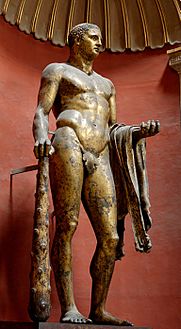 Hercules of the Forum Boarium (Hellenistic, 2nd century BCE)
Hercules of the Forum Boarium (Hellenistic, 2nd century BCE)
-
Hercules drunk and Omphale. Fresco from House of the Prince of Montenegro, Pompeii, 25–35 CE
-
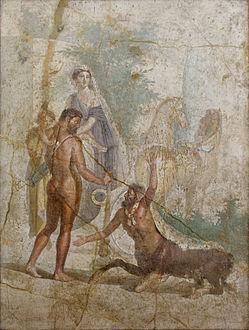 Hercules carrying his son Hyllus looks at the centaur Nessus, who is about to carry Deianira across the river on his back. Fresco from Pompeii, 30–45 CE
Hercules carrying his son Hyllus looks at the centaur Nessus, who is about to carry Deianira across the river on his back. Fresco from Pompeii, 30–45 CE
-
 Hercules in Olympus with Juno and Minerva, fresco from Herculaneum, 1st century CE
Hercules in Olympus with Juno and Minerva, fresco from Herculaneum, 1st century CE
-
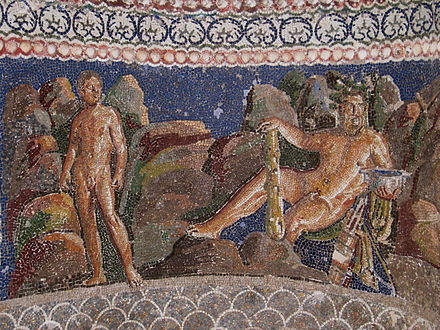 Hercules and Iolaus (1st century CE mosaic from the Anzio Nymphaeum, Rome)
Hercules and Iolaus (1st century CE mosaic from the Anzio Nymphaeum, Rome)
-
 Hercules (Hatra, Iraq, Parthian period, 1st–2nd century CE)
Hercules (Hatra, Iraq, Parthian period, 1st–2nd century CE)
-
 Hercules bronze statuette, 2nd century CE (museum of Alanya, Turkey)
Hercules bronze statuette, 2nd century CE (museum of Alanya, Turkey)
-
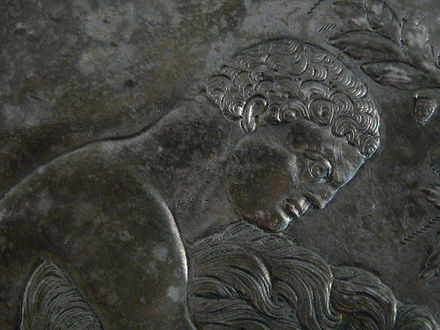 Hercules and the Nemean Lion (detail), silver plate, 6th century (Cabinet des Médailles, Paris)
Hercules and the Nemean Lion (detail), silver plate, 6th century (Cabinet des Médailles, Paris)
-
Heracles and Omphale, Roman fresco, Pompeian Fourth Style (45–79 CE), Naples National Archaeological Museum, Italy
-
A Roman gilded silver bowl depicting the boy Hercules strangling two serpents, from the Hildesheim Treasure, 1st century CE, Altes Museum
-
 Head from statue of Herakles (Hercules) Roman 117–188 CE from villa of the emperor Hadrian at Tivoli, Italy at the British Museum
Head from statue of Herakles (Hercules) Roman 117–188 CE from villa of the emperor Hadrian at Tivoli, Italy at the British Museum
-
 Hercules (Herakles) with the Apples of the Hesperides Roman 1st century CE from a temple at Byblos, Lebanon at the British Museum
Hercules (Herakles) with the Apples of the Hesperides Roman 1st century CE from a temple at Byblos, Lebanon at the British Museum
-
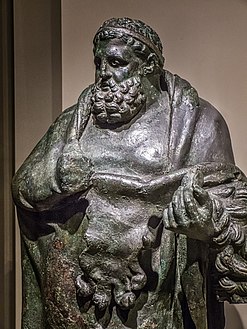 Hercules from Cappadocia or Caesarea 1st century BCE – 1st century CE, Walters Art Museum
Hercules from Cappadocia or Caesarea 1st century BCE – 1st century CE, Walters Art Museum
-
 Hercules slaying the Hydra Roman copy of 4th century BCE original by Lysippos, Capitoline Museum
Hercules slaying the Hydra Roman copy of 4th century BCE original by Lysippos, Capitoline Museum
-
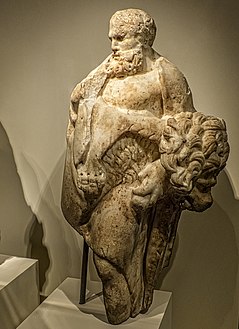 Hercules Roman 1st century BCE – 1st century CE, Walters Art Museum
Hercules Roman 1st century BCE – 1st century CE, Walters Art Museum
-
 Herakles and Telephos Louvre MR219
Herakles and Telephos Louvre MR219
-
Hercules, 50 BCE – 50 CE, MAN Florence
Modern era
-
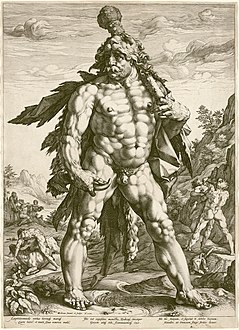 The Giant Hercules (1589) by Hendrik Goltzius
The Giant Hercules (1589) by Hendrik Goltzius
-
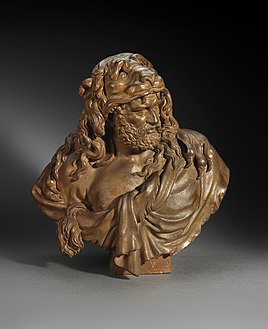 Lucas Faydherbe, Bust of Hercules – collection King Baudouin Foundation
Lucas Faydherbe, Bust of Hercules – collection King Baudouin Foundation
-
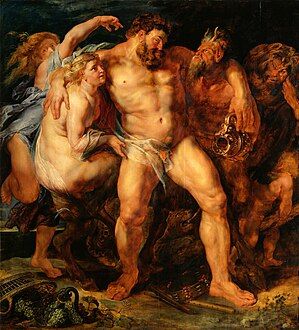 The Drunken Hercules (1612–1614) by Rubens
The Drunken Hercules (1612–1614) by Rubens
-
 Hercules and Deianira (18th century copy of a lost original), from I Modi
Hercules and Deianira (18th century copy of a lost original), from I Modi
-
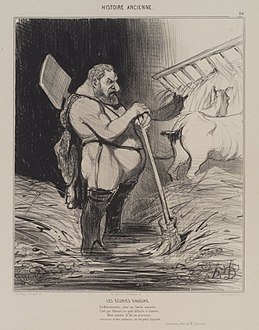 Hercules in the Augean stable (1842, Honoré Daumier)
Hercules in the Augean stable (1842, Honoré Daumier)
-
Comic book cover (c. 1958)
-
 Hercules, Deianira and the Centaur Nessus, by Bartholomäus Spranger, 1580–1582
Hercules, Deianira and the Centaur Nessus, by Bartholomäus Spranger, 1580–1582
-
 Henry IV of France, as Hercules vanquishing the Lernaean Hydra (i.e. the Catholic League), by Toussaint Dubreuil, c. 1600. Louvre Museum
Henry IV of France, as Hercules vanquishing the Lernaean Hydra (i.e. the Catholic League), by Toussaint Dubreuil, c. 1600. Louvre Museum
-
 Hercules on the Pyre by Guillaume Coustou The Elder, 1704, Louvre MR1809
Hercules on the Pyre by Guillaume Coustou The Elder, 1704, Louvre MR1809
In numismatics
Hercules was among the earliest figures on ancient Roman coinage, and has been the main motif of many collector coins and medals since. One example is the Austrian 20 euro Baroque Silver coin issued on September 11, 2002. The obverse side of the coin shows the Grand Staircase in the town palace of Prince Eugene of Savoy in Vienna, currently the Austrian Ministry of Finance. Gods and demi-gods hold its flights, while Hercules stands at the turn of the stairs.
-
 Juno, with Hercules fighting a Centaur on reverse (Roman, 215–15 BCE)
Juno, with Hercules fighting a Centaur on reverse (Roman, 215–15 BCE)
-
 Club over his shoulder on a Roman denarius (c. 100 BCE)
Club over his shoulder on a Roman denarius (c. 100 BCE)
-
 Maximinus II and Hercules with club and lionskin (Roman, 313 CE)
Maximinus II and Hercules with club and lionskin (Roman, 313 CE)
-
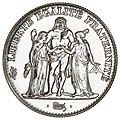 Commemorative 5-franc piece (1996), Hercules in center
Commemorative 5-franc piece (1996), Hercules in center
-
 Hercules, as seen on a Denarius of the Roman Emperor Caracalla. Dated 212 CE
Hercules, as seen on a Denarius of the Roman Emperor Caracalla. Dated 212 CE
Military
For ships named Hercules, see Hercules (ship).Six successive ships of the British Royal Navy, from the 18th to the 20th century, bore the name HMS Hercules.
In the French Navy, there were no less than nineteen ships called Hercule, plus three more named Alcide which is another name of the same hero.
Hercules' name was also used for five ships of the US Navy, four ships of the Spanish Navy, four of the Argentine Navy and two of the Swedish Navy, as well as for numerous civilian sailing and steam ships.
In modern aviation a military transport aircraft produced by Lockheed Martin carries the title Lockheed C-130 Hercules.
Operation Herkules was the German code-name given to an abortive plan for the invasion of Malta during the Second World War.
Other cultural references
-
 Pillars of Hercules, representing the Strait of Gibraltar (19th-century conjecture of the Tabula Peutingeriana)
Pillars of Hercules, representing the Strait of Gibraltar (19th-century conjecture of the Tabula Peutingeriana)
-
 The Cudgel of Hercules, a tall limestone rock formation, with Pieskowa Skała Castle in the background
The Cudgel of Hercules, a tall limestone rock formation, with Pieskowa Skała Castle in the background
-
 Hercules as heraldic supporters in the royal arms of Greece, in use 1863–1973. The phrase "Ηρακλείς του στέμματος" ("Defenders of the Crown") has pejorative connotations ("chief henchmen") in Greek.
Hercules as heraldic supporters in the royal arms of Greece, in use 1863–1973. The phrase "Ηρακλείς του στέμματος" ("Defenders of the Crown") has pejorative connotations ("chief henchmen") in Greek.
In films
For a list of films featuring Hercules, see Hercules in popular culture § Filmography.A series of nineteen Italian Hercules movies were made in the late 1950s and early 1960s. The actors who played Hercules in these films were Steve Reeves, Gordon Scott, Kirk Morris, Mickey Hargitay, Mark Forest, Alan Steel, Dan Vadis, Brad Harris, Reg Park, Peter Lupus (billed as Rock Stevens) and Michael Lane. A number of English-dubbed Italian films that featured the name of Hercules in their title were not intended to be movies about Hercules.
See also
- List of films featuring Hercules
- Hercules (comics)
- Hercules (constellation)
- Hercules in popular culture of the 20th and 21st centuries
- Sword-and-sandal
- Hercules: The Legendary Journeys
- Strength (Tarot card)
- Samson
- Gilgamesh
- Melqart
- Cú Chulainn
- Demigod
References
- Notes
- Louvre L.L. 325 Archived 2020-06-11 at the Wayback Machine.
- "Hercules". Collins English Dictionary. HarperCollins.
- "Hercules," in The Classical Tradition (Harvard University Press, 2010), p. 426.
- W. M. Lindsay, "Mehercle and Herc(v)lvs. " The Classical Quarterly 12.2 (April 1918:58).
- Festus 55 (edition of Lindsay); William Warde Fowler, The Roman Festivals of the Period of the Republic (London, 1908), p. 142; Karen K. Hersch, The Roman Wedding: Ritual and Meaning in Antiquity (Cambridge University Press, 2010), pp. 101, 110, 211.
- or, baritus, there being scribal variants. In the 17th century, the word entered the German language as barditus and was associated with the Celtic bards.
- Simek, Rudolf (2007:140–142) translated by Angela Hall. Dictionary of Northern Mythology. D.S. Brewer. ISBN 0-85991-513-1
- Servius, note to Aeneid 6.395 Archived 2020-08-01 at the Wayback Machine; Jane Chance, Medieval Mythography: From Roman North Africa to the School of Chartres, A.D. 433–1177 (University Press of Florida, 1994), p. 91.
- Chance, Medieval Mythography, pp. 168, 218, 413.
- Chance, Medieval Mythography, p. 219.
- Natale Conti, Mythologiae Book 7, Chapter 1, as translated by John Mulryan and Steven Brown (Arizona Center for Medieval and Renaissance Studies, 2006), vol. 2, p. 566.
- The official account, Labyrinthe royal... quoted in Jean Seznec, The Survival of the Pagan Gods, (B.F. Sessions, tr., 1995) p. 26
- ^ Dewitt, Norman (February 22, 2020). "Rome and the 'Road of Hercules'". Transactions and Proceedings of the American Philological Association. 72: 59–69. doi:10.2307/283041. JSTOR 283041.
- ^ Schultz, Cecelia (February 22, 2020). "Modern Prejudice and Ancient Praxis: Female Worship of Hercules at Rome". Zeitschrift für Papyrologie und Epigraphik. 133: 291–97.
- ^ Loar, Matthew (February 23, 2020). "Hercules, Mummius, and the Roman Triumph in Aeneid 8". Classical Philology. 112: 45–62. doi:10.1086/689726. S2CID 164402027.
- Grant, Mary. "Hyginus, Fabulae, 100–49". Theoi Texts Library. Retrieved March 7, 2020.
- ^ Loar, Matthew (February 23, 2020). "Hercules, Mummius, and the Roman Triumph in Aeneid 8". Classical Philology. 112: 45–62. doi:10.1086/689726. S2CID 164402027.
- Hercules almost suggests "Hero". The Classical and Hellenistic convention in frescoes and mosaics, adopted by the Romans, is to show women as pale-skinned and men as tanned dark from their outdoor arena of action and exercising in the gymnasium.(See also Reed.edu Archived 2006-05-06 at the Wayback Machine, jpg file. Reed.edu Archived 2006-08-23 at the Wayback Machine, subject).
- ^ Hinds, Aimee (23 June 2020). "Hercules in White: Classical Reception, Art and Myth". The Jugaad Project. Retrieved 2020-10-22.
- Sources
- Charlotte Coffin. "Hercules" Archived 2021-02-28 at the Wayback Machine in Peyré, Yves (ed.) A Dictionary of Shakespeare's Classical Mythology (2009)
- Bertematti, Richard (2014). "The Heracliad: The Epic Saga of Hercules" (Tridium Press). ISBN 0990302717
External links
 Texts on Wikisource:
Texts on Wikisource:
- "Hercules". The Nuttall Encyclopædia. 1907.
- "Hercules". The New Student's Reference Work. 1914.
- "Hercules and the Wagoner," by Aesop
- "Hercules," from Heroes Every Child Should Know by H. W. Mabie
- Hercules discovery in Israel
- Etruscan mirror illustrated Uni and Hercle
- Hercle and Menerva on an Etruscan mirror from Città di Castello, c. 300 BCE: Badisches
- The Apples of the Hesperides
- Images of Hercules
- Warburg Institute Iconographic Database (c. 2,950 images of Hercules)
| The Twelve Labours of Heracles | |
|---|---|